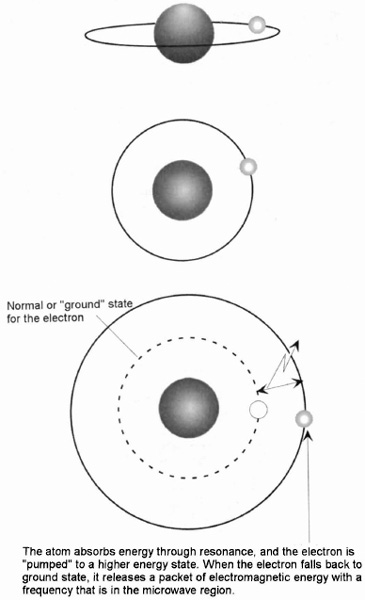The Giza Power Plant (27 page)

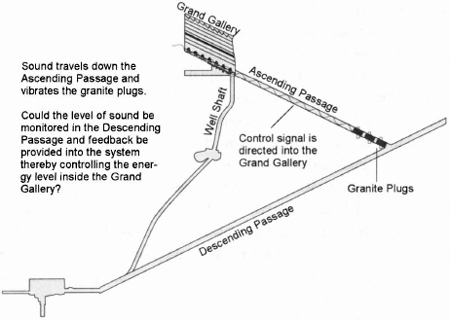
F
IGURE
49.
Granite Plugs
As I studied them, and envisioned their use, I realized that they may have been built into the structure to perform two critical roles. One would be to provide feedback to the power plant operators by responding to the sound that was generated inside the Grand Gallery and traveling down the
Ascending Passage. The operators of this machine could have attached vibration sensorsâmuch like the accelerometers that Danley usedâto the bottom granite plug that is accessible from the Descending Passage, and thereby had the ability to monitor the energy level inside the Grand Gallery. The other task these granite plugs may have performed could have been to respond to vibration from equipment in the Descending Passage and transmit out-of-phase interference sound waves into the Ascending Passage and Grand Gallery to prevent vibrations within from reaching destructive levels. These functions explain not only the builders' reasons for selecting granite instead of limestone for these blocks but also the means by which the ancient Egyptians controlled the energy level of the system. We also could speculate that by directing a signal of the correct frequency up the Ascending Passage, the Egyptians may have been able to prime the system. In other words, the entire system would be forced to vibrate, and once in motion, it would draw energy from the Earth with no further input.
When Petrie examined these blocks, he noted that the adjoining faces of the blocks were not flat but had a wavy finish ± .3 inches. He wrote:
These plug-blocks are cut out of boulder stones of red granite, and have not the faces cut sufficiently to remove the rounded outer surfaces at the corners: also the faces next to each other are never very flat, being wavy about plus or minus .300 inch. These particulars I was able to see, by putting my head in between the rounded edges of the 2nd and 3rd blocks from the top, which are not in contact; the 2nd having jammed tight 4 inches above the 3rd. The present top one is not the original end; it is roughly broken, and there is a bit of granite still cemented to the floor some way farther south of it. From appearances there I estimate that originally the plug was 24 inches beyond its present
end.
15
I was unable to confirm this when I was in Egypt because the blocks exposed by Al Mamun's tunnel had slipped since Petrie's day and are now resting against each other. (An interesting aside about Petrie's observations is that they fully dismiss and put to rest orthodox theories regarding the granite plugs being slid down the Ascending Passage. Some granite, in Petrie's
words, was "still cemented to the floor. . . ." This is indisputable proof that the granite plugs were positioned as the Great Pyramid was being built.) However, Petrie's observation makes for interesting speculation within the context of my theory. Were the faces of the blocks cut specifically to modify sound waves? Could the Ascending Passage serve to direct an interference out-of-phase sound wave into the Grand Gallery, thereby controlling the level of energy in the system? As I sought to answer these questions, more mysteries about the Great Pyramid revealed themselvesâand began to yield to the possible answers provided by my theory.
Chapter Ten
AN AMAZING MASER

T
he elements of this power system that we have discussed so far are
the crystal transducers contained within the King's Chamber granite, the chamber's tuned harmonic characteristics with the Earth, the acoustical properties of the Grand Gallery, and the design features (acoustic filters) of the Antechamber. How each of these elements fit together, with each reinforcing the other, becomes more significant as other elements of this energy system are brought to bear.
Obviously the above features are not all that are needed to make this system work. After transducing mechanical energy into electrical energy, there has to be a medium through which the electricity can flow and be utilized. In a modern power plant, steam passes across turbine blades causing rotation of a generator that stimulates electron flow through copper wires. In
this
power plant the vibrations from the Earth cause oscillations of the granite within the King's Chamber, and this vibrating mass of igneous, quartz-bearing rock influences the gaseous medium contained within the chamber. Currently this gaseous medium is air, but when this power plant operated, it was most likely hydrogen gas that filled the inner chambers of the Great Pyramid. The Queen's Chamber holds evidence that it was used to produce hydrogen, and we will look at this evidence in the next chapter. But first, we must look at the evidence for the technology that utilized this gas.
To maximize the output of the system, the atoms comprising this gaseous medium contained within the chamber should have a unique characteristicâthe gas's natural frequency should resonate in harmony with the entire system. To be more accurate, the resonance of the chamber, which can be adjusted, should resonate in harmony with the frequency of hydrogen, which does not change. Under these conditions, the hydrogen atoms would
more efficiently absorb the energy generated within the chamber. Atomic hydrogen is the simplest atom, with one proton and one electron, and is responsible for the emission of microwave energy in the universe. This microwave background radiation is left over from the Big Bang and was first observed in 1965 by Arno Penzias and Robert Wilson at the Bell Telephone Laboratories in Murray Hill, New Jersey. The radiation has virtually the same energy or temperature in all directions in the sky. If we look up at the night sky, we can see many bright regions with clusters of stars and bright planets piercing the black backdrop of the universe. The cosmic microwave background temperature, however, varies very little across the sky. This signal from the Big Bang is constant and has been bombarding the Earth since it first began to
form.
1
It is this signal from the universe that is an integral element in making the Giza power plant work. In order to understand how this could be, we need to understand how a maser works.
MASER is an acronym for Microwave Amplification through Stimulated Emission Radiation. The maser was developed before the laserâanother acronym, meaning Light Amplification through Stimulated Emission Radiationâwhich, when it was first developed, was called an optical maser. So let us take a brief look at how lasers and masers operate.
To understand how a maser works, it would be best to describe something we can all seeâlight. Most of the light we are familiar with is incoherent light. The light that fills our homes from a fluorescent tube after the flip of a switch is the result of an electrical discharge energizing the atoms in a gaseous medium and pumping the electrons into a higher orbit around the proton. The electrons cannot be sustained at this higher energy level indefinitely, and will eventually fall back to their original position, or "ground state," releasing a packet of electromagnetic energy in the process. This packet of energy is called a photon. These photons are what we see as light, and the properties of the photons, with respect to wavelength and frequency, depend on the atoms in the gas. We recognize these properties by the color of the light. With fluorescent, the emission of photons is random and the photons
travel in unpredictable directions (see Figure 50). The number of photons that are constantly being emitted is large enough that they will travel every conceivable direction possible, thereby illuminating a room.
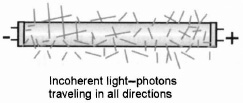
F
IGURE
50.
The Fluorescent Light
The uniqueness of the laser is based on the assumption that while photons in a light tube will travel in every direction, one of those directions will be along the length of the tube, parallel to its axis. If we place mirrors at both ends of the tube, therefore, and align these mirrors perfectly parallel with each other, the photons will reflect off the mirrors, back along the same axis they are traveling.
This is where the "stimulated emission" part of the laser comes in to play. A photon traveling back along its axis will encounter an atom with an electron in a higher energy state. The photon collides with the electron and forces it down to a lower energy state, which stimulates the release of another photon. Now there are two photons traveling together along the axis of the tube to the mirror at the other end. The train of two photons then becomes four photons, then eight, and so on (see Figure 51). With photons traveling at 186,282 miles per second, across a relatively short distance, the built up laser energy is almost
instantaneous.
2
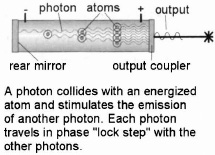
F
IGURE
51.
Principles of a LASER
A laser, however, is subject to the same runaway vibrations that we discussed earlier, as in the Tacoma Narrows Bridge disaster. The laser cavity is a resonator, and there has to be some release of the energy or the resonator will be destroyed. To accomplish this release, one mirror is coated with a material that allows a percentage of the laser energy to be transmitted through the substrate, while the remainder is fed back into the cavity to sustain the "lasing" action.
The light beam that is emitted from a laser is coherent, collimated (does not spread like the light from a flashlight), and monochromatic. In other words, light of single frequency, or color, passes through the end mirror in a tight pencil beam. Light travels in waves, and the waves of the laser beam are of the same wavelength, and are in phase, or "lock stepped" with each other. This is the "amplification" part of the laser. Because the beam is coherent
and collimated, the light cannot be seen until it strikes an object, such as a presentation screen, or as smoke in the air.
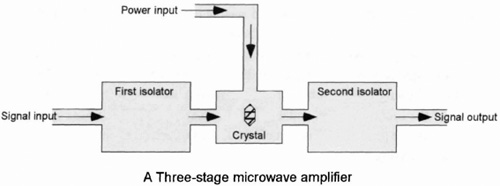
F
IGURE
52.
Microwave Amplifier
We know that a lightbulb is incoherent light energy, and, similarly, we can point to a microwave oven as an example of incoherent microwave energy. The maser operates a little differently from the laser in that its photons are in a different part of the electromagnetic spectrumânevertheless, its principle of operation is similar. There are many different designs and iterations of designs for both lasers and masers (see Figure 52). In the Great Pyramid, there is evidence that strongly indicates that the ancient Egyptian engineers and designers knew about and utilized the principles of a maser to collect the energy that was being drawn through the pyramid from the Earth and deliver it to the outside. This evidence can be found in the King's Chamber.
A power plant could be described as a large engine. As with any other kind of engine, fuel is fed into it and is converted into energy. This energy can then be converted to other forms of energyâsuch as mechanical or electrical energyâthat is then drawn off and used in whatever way is suitable. The key to converting or transducing hydrogen gas to usable power in the Giza power system was the introduction of acoustical vibration of the correct frequency and amplitude. (The amplitude is the amount of energy
contained within a sound wave.) Based on the previous evidence, sound must have been focused into the King's Chamber to force oscillations of the granite, creating in effect a vibrating mass of thousands of tons of granite. The frequencies inside this chamber, then, would rise above the low frequency of the Earthâthrough a scale of harmonic stepsâto a level that would excite the hydrogen gas to higher energy levels. The King's Chamber is a technical wonder. It is where Earth's mechanical energy was converted, or transduced, into usable power. It is a resonant cavity in which sound was focused. Sound roaring through the passageway at the resonant frequency of this chamberâor its harmonicâat sufficient amplitude would drive these granite beams to vibrate in resonance. Sound waves not of the correct frequency would be filtered in the acoustic filter, more commonly known as the Antechamber (see Figure 53).
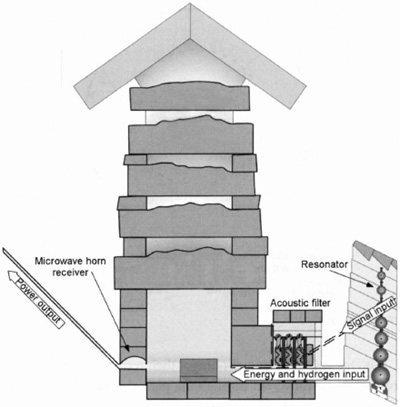
F
IGURE
53.
The Power Center
